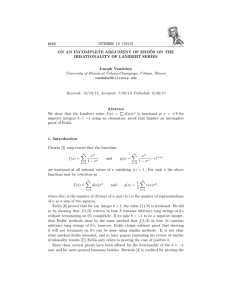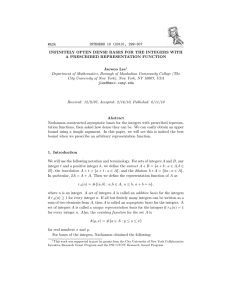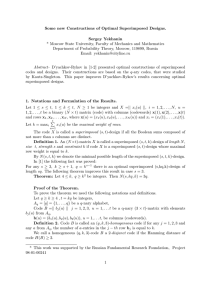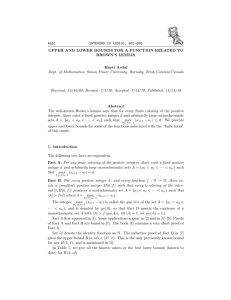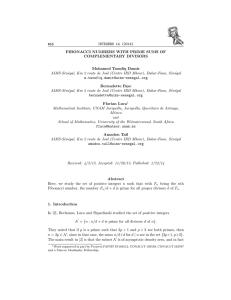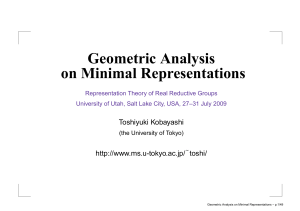INTEGERS 14 (2014) #A40 IRRATIONAL NUMBERS ASSOCIATED TO SEQUENCES WITHOUT GEOMETRIC PROGRESSIONS
advertisement
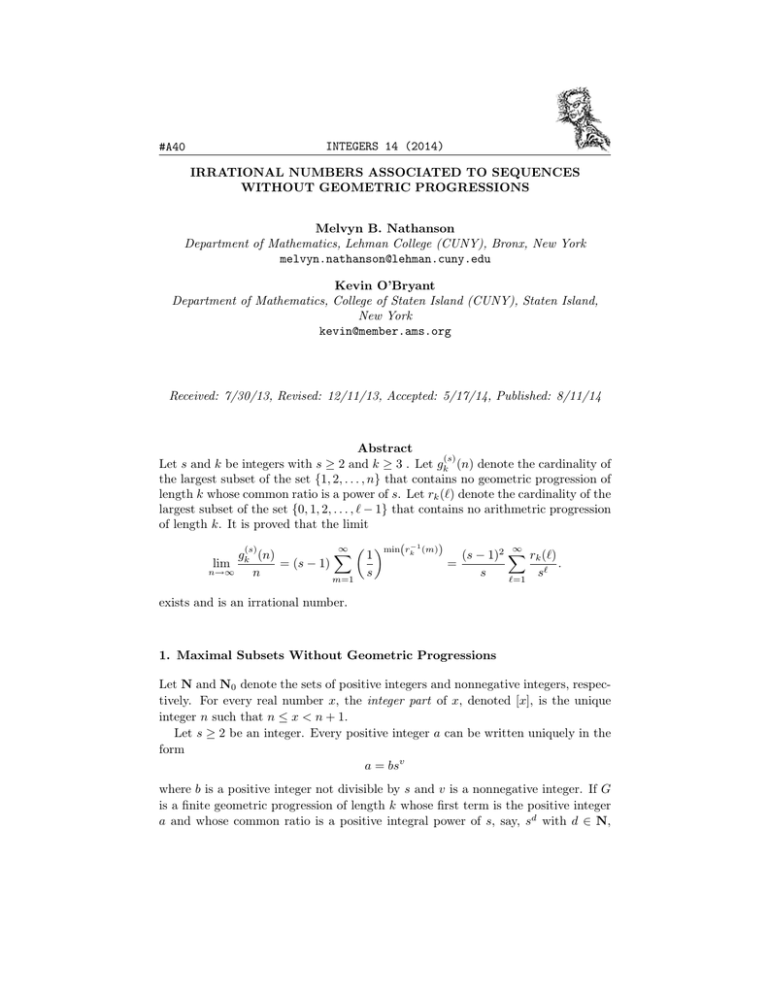
INTEGERS 14 (2014)
#A40
IRRATIONAL NUMBERS ASSOCIATED TO SEQUENCES
WITHOUT GEOMETRIC PROGRESSIONS
Melvyn B. Nathanson
Department of Mathematics, Lehman College (CUNY), Bronx, New York
melvyn.nathanson@lehman.cuny.edu
Kevin O’Bryant
Department of Mathematics, College of Staten Island (CUNY), Staten Island,
New York
kevin@member.ams.org
Received: 7/30/13, Revised: 12/11/13, Accepted: 5/17/14, Published: 8/11/14
Abstract
(s)
Let s and k be integers with s 2 and k 3 . Let gk (n) denote the cardinality of
the largest subset of the set {1, 2, . . . , n} that contains no geometric progression of
length k whose common ratio is a power of s. Let rk (`) denote the cardinality of the
largest subset of the set {0, 1, 2, . . . , ` 1} that contains no arithmetric progression
of length k. It is proved that the limit
(s)
g (n)
lim k
= (s
n!1
n
1)
1 ✓ ◆min(rk
X
1
m=1
s
1
(m))
=
(s
1
1)2 X rk (`)
.
s
s`
`=1
exists and is an irrational number.
1. Maximal Subsets Without Geometric Progressions
Let N and N0 denote the sets of positive integers and nonnegative integers, respectively. For every real number x, the integer part of x, denoted [x], is the unique
integer n such that n x < n + 1.
Let s 2 be an integer. Every positive integer a can be written uniquely in the
form
a = bsv
where b is a positive integer not divisible by s and v is a nonnegative integer. If G
is a finite geometric progression of length k whose first term is the positive integer
a and whose common ratio is a positive integral power of s, say, sd with d 2 N,
2
INTEGERS: 14 (2014)
then
G = {a sd
j
: j = 0, 1, . . . , k
1}.
Writing a in the form a = bsv with b not a multiple of s, we have
G = {bsv+dj : j = 0, 1, . . . , k
1} ✓ {bsi : i 2 N0 }
(1)
and so the set of exponents of s in the finite geometric progression G is the finite
arithmetic progression {v + dj : j = 0, 1, . . . , k 1}. Conversely, if a, d 2 N and
{v1 + dj : j = 0, 1, . . . , k 1} is a finite arithmetic progression of k nonnegative
integers, then {asv1 +dj : j = 0, 1, . . . , k 1} is a geometric progression of length k.
Writing a = bsv0 with v0 2 N0 and b not divisible by s, we obtain {asv1 +dj : j =
0, 1, . . . , k 1} = {bsv+dj : j = 0, 1, . . . , k 1}, where v = v0 + v1 .
Let ` and k be positive integers with k 3. Let rk (`) denote the cardinality of the
largest subset of the set {0, 1, 2, . . . , ` 1} that contains no arithmetic progression of
length k. Because the geometric progression (2i )1
i=0 contains no 3-term arithmetic
progression, it follows that
lim rk (`) = 1.
(2)
`!1
Note that rk (`) = ` for ` = 1, . . . , k 1, that rk (k) = k
` 2 N, there exists "` 2 {0, 1} such that
1, and that, for every
rk (` + 1) = rk (`) + "` .
(3)
Equivalently,
0 rk (` + 1)
rk (`) 1.
(4)
It follows from (2) and (4) that the function rk : N ! N is increasing and surjective.
This implies that, for every positive integer m, the set
rk 1 (m) = {` 2 N : rk (`) = m}
is a nonempty set of consecutive integers. We define
um = min rk 1 (m) .
Then (um )1
m=1 is a strictly increasing sequence of positive integers.
Lemma 1. Let k
3 and let um = min rk 1 (m) for m 2 N. Then
lim sup(um+1
m!1
um ) = 1.
Proof. We use Szemerédi’s theorem, which states that rk (`) = o(`), to prove that
the increasing sequence (um )1
m=1 has unbounded gaps.
3
INTEGERS: 14 (2014)
c
Note that u1 = 1. If lim supm!1 (um+1 um ) < 1, then there is an integer
2 such that um+1 um < c for all m 2 N. It follows that
max rk 1 (m) + 1 = min rk 1 (m + 1)
= um+1
m
X
=
(ui+1
ui ) + u1
i=1
< cm + 1.
Thus, max rk 1 (m) < cm and so rk (cm) > m. Equivalently,
rk (cm)
1
> >0
cm
c
for all m 2 N. This contradicts Szemerédi’s theorem, and completes the proof.
For k
3, let gk (n) denote the cardinality of the largest subset of the set
{1, 2, . . . , n} that contains no geometric progression of length k. This function,
introduced by Rankin [4], has been investigated by M. Beiglböck, V. Bergelson,
N. Hindman, and D. Strauss [1], by Brown and Gordon [2], and by Riddell [5]. The
best upper bound for the function gk (n) is due to Nathanson and O’Bryant [3].
(s)
For s 2 and k 3, let gk (n) denote the cardinality of the largest subset of the
set {1, 2, . . . , n} that contains no geometric progression of length k whose common
ratio is a power of s. The goal of this paper is to prove that the limit
(s)
g (n)
lim k
= (s
n!1
n
1)
1 ✓ ◆min(rk
X
1
m=1
1
(m))
s
=
(s
1
1)2 X rk (`)
s
s`
`=1
exists and converges to an irrational number.
2. Maximal Geometric Progression-Free Sets
Lemma 2. Let k, s, and n be positive integers with k
3 and s
Bn = {b 2 {1, 2, . . . , n} : s does not divide b}.
Then
(s)
gk (n) =
X
b2Bn
⇣
h
⇣ n ⌘i⌘
rk 1 + logs
.
b
2, and let
(5)
4
INTEGERS: 14 (2014)
Proof. Let b 2 Bn . For i 2 N0 , we have bsi n if and only if 0 i logs (n/b).
We define
T (b) = {t 2 {1, 2, . . . , n} : t = bsi for some i 2 N0 }
n
h
⇣ n ⌘io
= bsi : i = 0, 1, . . . , logs
.
b
Then b 2 T (b) and
{1, 2, . . . , n} =
[
T (b)
b2Bn
is a partition of {1, 2, . . . , n} into pairwise disjoint nonempty subsets.
If the set {1, 2, . . . , n} contains a finite geometric progression of length k whose
common ratio is a power of s, then, by (1), this geometric progression is a subset of
T (b) for some b 2 Bn , and the set of exponents of s is a finite arithmetic progression
of length k contained in the set of consecutive integers {0, 1, . . . , [logs (n/b)]}. It
follows that the largest cardinality of a subset of T (b) that contains no k-term
geometric progression whose common ratio is a power of s is equal to the largest
cardinality of a subset of {0, 1, . . . , [logs (n/b)]} that contains no k-term arithmetic
progression. This number is
⇣
h
⇣ n ⌘i⌘
rk 1 + logs
.
b
If An is a subset of {1, 2, . . . , n} of maximum cardinality that contains no k-term
geometric progression whose common ratio is a power of s, then
⇣
h
⇣ n ⌘i⌘
|An \ T (b)| = rk 1 + logs
.
b
S
Because A = b2Bn T (b) is a partition of {1, . . . , n}, it follows that
h
⇣ n ⌘i⌘
X
X ⇣
|An | =
|An \ T (b)| =
rk 1 + logs
.
b
b2Bn
b2Bn
This completes the proof.
3. Construction of an Irrational Number
Lemma 3. Let s be an integer with s 2. Let x and y be real numbers with x < y.
The number of integers n such that x < n y and s does not divide n is
✓
◆
s 1
(y x) + O(1).
s
Proof. This is a straightforward calculation.
5
INTEGERS: 14 (2014)
Theorem 1. Let k and s be integers with k
3 and s
1
(s)
g (n)
(s 1)2 X rk (`)
lim k
=
= (s
n!1
n
s
s`
1)
`=1
2. The limit
1 ✓ ◆min(rk
X
1
m=1
1
(m))
s
exists and converges to an irrational number.
Proof. For every positive integer b we have
1 + [logs (n/b)] = `
if and only if
n
sn
<b `.
s`
s
By Lemma 3, the number of integers in this interval that are also in Bn , that is, are
not divisible by s, is
✓
◆
s 1 (s 1)n
n(s 1)2
+
O(1)
=
+ O(1).
s
s`
s`+1
Let n
s. Because 1 2 Bn , we have
L(n) = max {1 + [logs (n/b)] : b 2 Bn } = 1 + [logs n] 2 logs n,
Also, if ` L(n), then rk (`) ` L(n). By Lemma 2,
X
(s)
gk (n) =
rk (1 + [logs (n/b)])
b2Bn
L(n)
=
X
`=1
rk (`) ⇥ |{b 2 Bn : ` = 1 + [logs (n/b)]}|
◆
n(s 1)2
+
O(1)
s`+1
`=1
0
1
L(n)
2 L(n)
X
X
n(s 1)
rk (`)
=
+O@
rk (`)A
s
s`
L(n)
=
X
rk (`)
✓
`=1
=
n(s
0
`=1
L(n)
⇣
⌘
1)2 X rk (`)
2
+
O
L(n)
s
s`
`=1
1
✓ 2 ◆
L(n)
1)2 X rk (`)
logs n A
=n
+O
s
s`
n
`=1
0
1
2 L(n)
X rk (`)
(s
1)
= n@
+ o(1)A .
s
s`
@ (s
`=1
6
INTEGERS: 14 (2014)
Because (L(n))1
n=1 is an increasing sequence and limn!1 L(n) = 1, we have
0
1
1
(s)
2 L(n)
2 X
X rk (`)
gk (n)
(s
1)
rk (`)
A = (s 1)
lim
= lim @
+
o(1)
.
`
n!1
n!1
n
s
s
s
s`
`=1
`=1
Let M (n) = rk (L(n)) and let um = min rk 1 (m) and Um = max rk 1 (m) . Then
M (n) L(n) and Um + 1 = um+1 for m = 1, . . . , M (n). We have
L(n)
(n) 1
X rk (`) MX
=
m
s`
m=1
`=1
X
`2rk 1 (m)
M (n) 1
X
=
m
m=1
1
+ M (n)
s`
Um
X
1
+ M (n)
s`
`=um
X
`2rk 1 (M (n))\{1,...,L(n)}
L(n)
X
`=uM (n)
1
s`
1
s`
✓ ◆um ✓ ◆Um +1 !
M (n) 1
X
s
1
1
=
m
s 1 m=1
s
s
✓ ◆uM (n) ✓ ◆L(n)+1 !
s
1
1
+
M (n)
s 1
s
s
✓✓ ◆um ✓ ◆um+1 ◆
1
1
s 1 m=1
s
s
✓ ◆uM (n) ✓ ◆L(n)+1 !
s
1
1
+
M (n)
s 1
s
s
0
1
✓ ◆um M
✓ ◆um
✓ ◆L(n)+1
M (n)
(n)
X
s @X
1
1
1
A
=
m
(m 1)
M (n)
s 1 m=1
s
s
s
m=2
=
=
M (n) 1
X
s
=
M (n)
s
s
1
m=1
M (n)
s
s
X
1
X
m=1
m
1
1
sum
1
sum
s
1
✓
M (n)
sL(n)
◆
+ o(1).
Therefore,
(s)
gk (n)
n
=
2
(s
= (s
s
0
1) @ s
s 1
1)
M (n) ✓
X
m=1
1
s
M (n) ✓
X
m=1
◆um
1
s
◆um
+ o(1)
1
+ o(1)A + o(1)
7
INTEGERS: 14 (2014)
and so
1
(s)
X
gk (n)
s 1
=
.
n!1
n
sum
m=1
lim
Note that u1 = 1. The infinite series converges to a real number ✓s 2 (1 1/s, 1),
and the “decimal digits to base s” of ✓s are 0 or s 1. The number ✓s is rational
if and only if these digits are eventually periodic, but Lemma 1 implies that there
are unbounded gaps between successive digits equal to 1. Therefore, ✓ is irrational.
This completes the proof.
4. Two Remarks
The irrationality statement in Theorem 1 is a special case of the following observation.
Theorem 2. Let (an )1
n=1 be an unbounded sequence of positive integers such that
0 an an 1 s 1 for all n 2. If an = o(n), then, for every integer s 2,
P1
the real number n=1 an /sn is irrational.
Pn
Proof. Let "1 = a1 and let "n = an an 1 for n 2. Then "n 0 and an = i=1 "i
for all n 2.
Suppose there exist positive integers c and n0 such that an+c an
1 for all
n n0 . It follows that for every positive integer k we have
an0 +kc = an0 +
k
X
(an0 +ic
an0 +(i
1)c )
an0 + k
i=1
and so
an
an0 +kc
= lim
n!1 n
k!1 n0 + kc
an0 + k
k
lim inf
lim inf
k!1 n0 + kc
k!1 n0 + kc
1
= >0
c
0 = lim
which is absurd. Therefore, for every positive integer c there exist infinitely many
positive integers n such that
n+c
X
"i = an+c
an = 0
i=n+1
and so "i = 0 for i = n+1, . . . , n+c. Thus, the sequence ("i )1
i=1 contains arbitrarily
long finite sequences of zeros. Because the sequence (an )1
n=1 is unbounded, it is not
8
INTEGERS: 14 (2014)
1
eventually constant, and so ("i )1
i=1 is not eventually zero. It follows that ("i )i=1 is
not eventually periodic. We have
1
1
n
X
X
an
1 X
=
"i
sn
sn i=1
n=1
n=1
1
X
1
X
1
=
"i
n
s
i=1
n=i
=
s
s
1
1
X
"i
i=1
si
.
P1
Because ("i )1
s” of i=1 "i s i and
i=1 is the sequence of “decimal digits to base
P
1
n
because ("i )1
is irrational.
i=1 is not eventually periodic, it follows that
n=1 an s
(s)
We define the function ĝk (n) as the cardinality of the largest subset of {1, 2, . . . , n}
that contains no geometric progression of length k with common ratio s. Recall that
Bn = {b 2 {1, 2, . . . , n} : s does not divide b}.
Theorem 3. Let s 2 and k 3 be integers, and let Y ⇤ be the set of all integers
in {1, . . . , n} of the form bsqk 1 with b 2 Bn and q 2 N. Then X ⇤ = {1, . . . , n} \ Y ⇤
contains no k-term geometric progression with common ratio s, and
(s)
ĝk (n) = |X ⇤ | .
(6)
Moreover,
(s)
ĝk (n)
sk
= k
n!1
n
s
lim
s
.
1
Proof. Every k-term geometric progression of positive integers with common ratio
s is of the form {bsv+i : i = 0, 1, . . . , k 1} for some b 2 Bn and v 2 N0 , and so the
set of exponents of s is a complete system of residues modulo k, hence contains an
integer congruent to k 1 modulo k. It follows that the set
X ⇤ = bsqk
i
2 {1, . . . , n} : b 2 Bn , q 2 N, and i 2 {2, 3, . . . , k}
(7)
contains no k-term geometric progression with common ratio s.
Let X0 be any subset of {1, . . . , n} that contains no k-term geometric progression
with common ratio s. We shall prove that |X0 | |X ⇤ |. For each b 2 Bn , the set
X0 does not contain the geometric progression {bsk i : i = 1, 2, . . . , k}. It follows
that the set
X1 = X0 [ {bsk
i
: i = 2, 3, . . . , k} \ {bsk
1
: b 2 Bn }
also contains no k-term geometric progression with common ratio s. Moreover,
|X1 | |X0 |.
For q 2 N, let Xq be a subset of {1, . . . , n} such that
9
INTEGERS: 14 (2014)
(i) Xq contains no k-term geometric progression with common ratio s,
(ii)
q n
[
0
bsq k
i
q 0 =1
(iii)
If bs(q+1)k
If bs(q+1)k
1
1
n 0
bsq k
1
o
: i = 2, 3, . . . , k ✓ Xq
o
: q 0 = 1, . . . , q \ Xq = ;.
> n, let
⇣
n
Xq+1 = Xq [ bs(q+1)k
n, let
⇣
n
Xq+1 = Xq [ bs(q+1)k
i
i
: i = 2, 3, . . . , k
: i = 2, 3, . . . , k
o⌘
o⌘
\ {1, . . . , n}.
\ {bs(q+1)k
1
}.
In both cases, the set Xq+1 contains no k-term geometric progression with common
ratio s, and |Xq+1 |
|Xq |. Continuing inductively, we obtain the set X ⇤ (b) ✓
{1, 2, . . . , n} such that
(i) X ⇤ (b) contains no k-term geometric progression with common ratio s,
(ii) n0 2 X ⇤ (b) if n0 2 {1, 2, . . . , n} and n0 = bsqk
{2, 3, . . . , k},
(iii) bsqk
1
i
for some q 2 N and i 2
2
/ X ⇤ (b) for all q 2 N,
(iv) |X0 | |X ⇤ (b)|.
Iterating this construction with X0 = X ⇤ (b) and b0 2 Bn \ {b}, we obtain the set
X ⇤ defined by (7). The inequality |X0 | |X ⇤ | implies (6).
We shall estimate the cardinality of the set
Y ⇤ = {1, 2, . . . , n} \ X ⇤ = bsqk
If bsqk
1
2 Y ⇤ and n
1
2 {1, . . . , n} : b 2 Bn and q 2 N .
s, then
q
For q logs n, we have bsqk
1
(logs n
k
1
logs b + 1) logs n.
2 {1, . . . , n} if s does not divide b and
0<b
By Lemma 3, the number of such b is
n
sqk
1
.
10
INTEGERS: 14 (2014)
✓
s
1
s
◆
n
sqk
1
+ O(1) =
(s
1)n
+ O(1)
sqk
and so
[logs n]
X (s
|Y ⇤ | =
q=1
= n(s
=
n(s
sk
Therefore
1)n
sqk
+ O(logs n)
0
1
1
1
X
X
1
1
A + O(logs n)
1) @
qk
qk
s
s
q=1
q=[logs n]+1
✓
◆
1)
1
1
+ O(logs n).
1
s[logs n]k
|Y ⇤ |
s
= k
n
s
1
+O
1
✓
1
nk
◆
+O
✓
logs n
n
◆
and
(s)
ĝk (n)
=1
n
=1
=
sk
sk
|Y ⇤ |
n
✓ ◆
✓
◆
s 1
1
logs n
+
O
+
O
sk 1
nk
n
s
+ o(n).
1
This completes the proof.
5. Open Problems
1. Let k and s be integers with k
3 and s
(s)
g (n)
lim k
= (s
n!1
n
1)
2. Is the number
1 ✓ ◆min(rk
X
1
m=1
1
(m))
s
transcendental?
2. Let um = min rk 1 (m) for m 2 N. Prove that the sequence (um )1
m=1 is not
eventually periodic without using Szemerédi’s theorem.
(s0 )
(s)
3. Let s and s0 be integers with 2 s < s0 . Is it true that gk (n) gk (n) for
(s0 )
(s)
all n 2 N and that gk (n) < gk (n) for all sufficiently large integers n?
11
INTEGERS: 14 (2014)
4. Let S be a finite set of integers such that s
2 for all s 2 S. For k
3,
(S)
let gk (n) denote the cardinality of the largest subset of the set {1, 2, . . . , n}
that contains no geometric progression of length k whose common ratio is a
power of s for some s 2 S. Does
(S)
gk (n)
n!1
n
lim
exist? If so, can this limit be expressed by an infinite series analogous to (5)?
Acknowledgement We thank the referee for several useful comments.
References
[1] M. Beiglböck, V. Bergelson, N. Hindman, and D. Strauss, Multiplicative structures in additively large sets, J. Combin. Theory Ser. A 113 (2006), no. 7, 1219–1242.
[2] B. E. Brown and D. M. Gordon, On sequences without geometric progressions, Math. Comp.
65 (1996), no. 216, 1749–1754.
[3] M. B. Nathanson and K. O’Bryant, On sequences without geometric progressions, Integers 13
(2013), #A73, 1–5.
[4] R. A. Rankin, Sets of integers containing not more than a given number of terms in arithmetical progression, Proc. Roy. Soc. Edinburgh Sect. A 65 (1960/1961), 332–344.
[5] J. Riddell, Sets of integers containing no n terms in geometric progression, Glasgow Math.
J. 10 (1969), 137–146.



